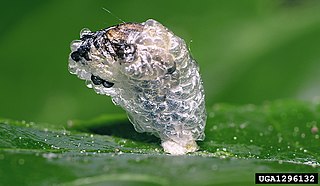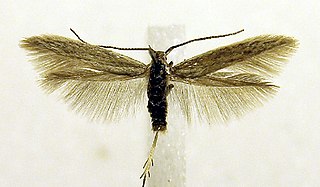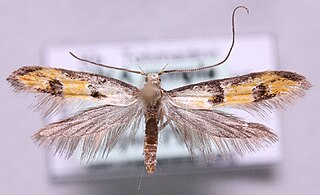
Dermestidae are a family of Coleoptera that are commonly referred to as skin beetles. Other common names include larder beetle, hide or leather beetles, carpet beetles, and khapra beetles. There are over 1,100 species described.

The Agromyzidae are a family commonly referred to as the leaf-miner flies, for the feeding habits of their larvae, most of which are leaf miners on various plants.

Rat-tailed maggots are the larvae of certain species of hoverflies belonging to the tribes Eristalini and Sericomyiini. A characteristic feature of rat-tailed maggots is a tube-like, telescoping breathing siphon located at its posterior end. This acts like a snorkel, allowing the larva to breathe air while submerged. The siphon is usually about as long as the maggot's body, but can be extended as long as 150 mm (5.9 in). This organ gives the larva its common name.

Eristalinae are one of the four subfamilies of the fly family Syrphidae, or hoverflies. A well-known species included in this subfamily is the dronefly, Eristalis tenax.

Coleophora limosipennella is a moth of the family Coleophoridae described by Philogène Auguste Joseph Duponchel in 1843. It is found in Europe from Fennoscandia to the Pyrenees, Italy and the Balkan Peninsula and from Great Britain to the Baltic States and Romania. It is an introduced species in North America.

Estigmene acrea, the salt marsh moth or acrea moth, is a moth in the family Erebidae. The species was first described by Dru Drury in 1773. It is found in North America, the Democratic Republic of the Congo, Kenya, Colombia, Mexico.

Coleophora kuehnella is a moth of the family Coleophoridae. It was first described by Johann Goeze in 1783 and is found in Asia and Europe.

Coleophora peribenanderi is a moth of the family Coleophoridae.

Coleophora acrisella is a moth of the family Coleophoridae. It is found from the Czech Republic to the Iberian Peninsula, Italy and Greece and from France to Hungary.
Coleophora adelogrammella is a moth of the family Coleophoridae. It is found from Fennoscandia to the Iberian Peninsula, Corsica, Italy, North Macedonia and Thrace and from France to Hungary.

Coleophora boreella is a moth of the family Coleophoridae. It is found from Fennoscandia and northern Russia to the Netherlands and Poland.

Coleophora cornutella is a moth of the family Coleophoridae. It is found from Fennoscandia to the Pyrenees and the Alps and from France to Romania.

Coleophora ledi is a moth of the family Coleophoridae. It is found from Fennoscandia and northern Russia to the Pyrenees and the Alps. In the east, it ranges to Japan. Outside of Eurasia, it is known from North America where it is found in eastern Canada, Michigan, and Alaska.
Coleophora longicornella is a moth of the family Coleophoridae. It is found from France to Italy, Greece and Hungary.
Coleophora onobrychiella is a moth of the family Coleophoridae. It is found from Sweden to the Pyrenees, Italy and Greece and from France to Romania. It is also found in China.

The cherry casebearer moth is a moth of the family Coleophoridae. It is found in North America, including New York, Oklahoma, Utah, Ontario and British Columbia.
Coleophora levantis is a moth of the family Coleophoridae. It is found on the island of Honshu in Japan.

Heinemannia laspeyrella is a species of moth of the family Elachistidae. It is found in northern, central and eastern Europe. In the east, the range extends up the Ural and in the south to Siberia.

Whittleia is a genus of moths of the Psychidae family.

The Lichen Case-bearer is a moth of the Psychidae family. It is found in Europe and has also been recorded in North America.















